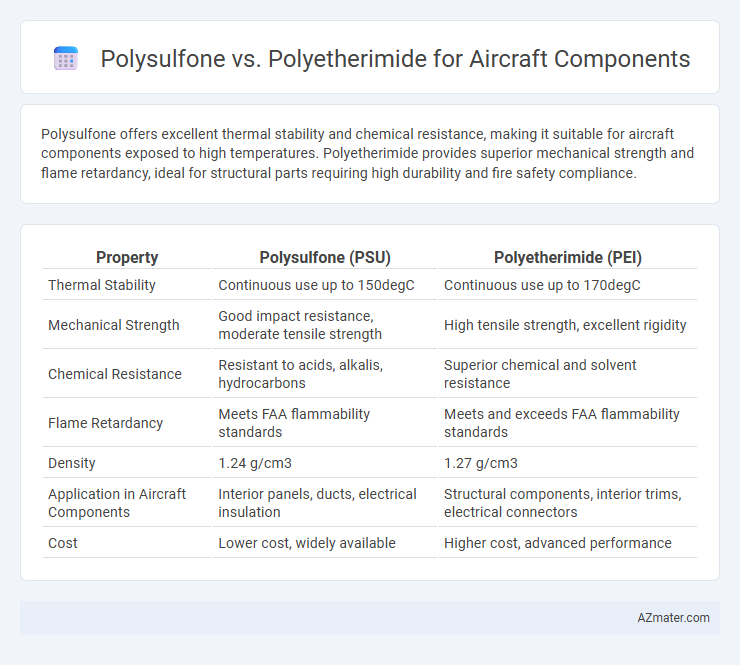Polysulfone offers excellent thermal stability and chemical resistance, making it suitable for aircraft components exposed to high temperatures. Polyetherimide provides superior mechanical strength and flame retardancy, ideal for structural parts requiring high durability and fire safety compliance.
Table of Comparison
| Property | Polysulfone (PSU) | Polyetherimide (PEI) |
|---|---|---|
| Thermal Stability | Continuous use up to 150degC | Continuous use up to 170degC |
| Mechanical Strength | Good impact resistance, moderate tensile strength | High tensile strength, excellent rigidity |
| Chemical Resistance | Resistant to acids, alkalis, hydrocarbons | Superior chemical and solvent resistance |
| Flame Retardancy | Meets FAA flammability standards | Meets and exceeds FAA flammability standards |
| Density | 1.24 g/cm3 | 1.27 g/cm3 |
| Application in Aircraft Components | Interior panels, ducts, electrical insulation | Structural components, interior trims, electrical connectors |
| Cost | Lower cost, widely available | Higher cost, advanced performance |
Introduction to Advanced Polymers in Aerospace
Polysulfone (PSU) and Polyetherimide (PEI) are high-performance polymers extensively used in aerospace due to their exceptional thermal stability, chemical resistance, and mechanical strength. PSU offers excellent dimensional stability and resistance to hydrolysis, making it suitable for aircraft interior components exposed to harsh environments. PEI provides superior heat resistance and flame retardance, ideal for structural parts demanding high strength-to-weight ratios in advanced aerospace applications.
Overview of Polysulfone (PSU)
Polysulfone (PSU) is a high-performance thermoplastic known for its excellent thermal stability, mechanical strength, and resistance to hydrolysis, making it suitable for demanding aerospace applications such as aircraft components. Its glass transition temperature typically ranges around 185degC, providing reliable performance under elevated temperatures encountered in flight environments. PSU offers excellent dimensional stability and resistance to chemicals, contributing to its use in components requiring long-term durability and lightweight properties.
Overview of Polyetherimide (PEI)
Polyetherimide (PEI) is a high-performance thermoplastic known for its exceptional mechanical strength, thermal stability up to 217degC, and excellent chemical resistance, making it ideal for demanding aerospace applications. Compared to polysulfone, PEI offers superior dimensional stability and higher glass transition temperature, critical for aircraft components exposed to extreme environments. Its lightweight nature combined with flame retardancy and low smoke generation enhances safety and efficiency in aircraft interior and structural parts.
Mechanical Properties Comparison
Polysulfone (PSU) exhibits high tensile strength and excellent impact resistance, making it suitable for aircraft components requiring durability under mechanical stress. Polyetherimide (PEI) outperforms PSU with higher flexural modulus and superior thermal stability, enabling enhanced performance in high-temperature environments typical in aerospace applications. Both polymers offer excellent chemical resistance, but PEI's superior mechanical properties and heat deflection temperature make it the preferred choice for critical structural aircraft parts.
Thermal Resistance and Performance
Polysulfone exhibits excellent thermal resistance with a continuous service temperature up to 170degC, making it suitable for moderate heat aircraft components. Polyetherimide outperforms polysulfone, maintaining structural integrity at continuous use temperatures up to 215degC and offering superior mechanical strength under thermal stress. Polyetherimide's enhanced thermal stability and chemical resistance make it a preferred choice for high-performance aircraft parts requiring long-term durability in elevated temperature environments.
Chemical Resistance and Environmental Stability
Polysulfone exhibits exceptional chemical resistance to acids, bases, and hydrocarbons, making it suitable for harsh aerospace environments, while polyetherimide offers superior thermal stability and maintains structural integrity under high-temperature conditions. Polyetherimide's enhanced environmental stability ensures reliable performance against UV radiation and hydrolytic degradation, critical for aircraft components exposed to fluctuating atmospheric conditions. The choice between polysulfone and polyetherimide hinges on specific exposure profiles, with polysulfone favored for aggressive chemical environments and polyetherimide preferred for elevated thermal and environmental stress resistance.
Weight and Structural Considerations
Polysulfone (PSU) offers a high strength-to-weight ratio with excellent thermal stability, making it suitable for moderately stressed aircraft components where weight savings are critical. Polyetherimide (PEI) provides superior mechanical strength and higher thermal resistance, enabling thinner and lighter structures to withstand increased structural loads. Both polymers balance weight and durability, but PEI's enhanced mechanical properties often result in more optimized lightweight aircraft components under demanding structural conditions.
Processing and Manufacturability
Polysulfone (PSU) and Polyetherimide (PEI) both offer high thermal stability and chemical resistance, but PEI exhibits superior processability for complex aircraft components due to its higher glass transition temperature (around 217degC) compared to PSU (approximately 185degC), enabling better performance under aerospace thermal conditions. PEI's enhanced mechanical properties and flow characteristics facilitate advanced manufacturing techniques such as injection molding and thermoforming, resulting in reduced cycle times and improved dimensional stability for intricate parts. PSU, while easier to machine and weld, may present challenges in high-precision aerospace applications due to its relatively lower thermal limits and slower crystallization rates, affecting manufacturing efficiency.
Cost Implications for Aerospace Applications
Polysulfone offers a more cost-effective solution for aircraft components due to its lower raw material and processing costs compared to Polyetherimide, which commands a premium price for its superior thermal and mechanical properties. Polyetherimide, while more expensive, provides enhanced flame retardancy and higher glass transition temperature, justifying its use in critical aerospace applications where performance outweighs cost considerations. Manufacturers must balance the budget constraints with performance requirements, often reserving Polyetherimide for components exposed to extreme thermal or mechanical stress.
Application Suitability: Choosing Between PSU and PEI
Polyetherimide (PEI) offers superior mechanical strength, thermal stability up to 217degC, and excellent flame resistance, making it ideal for aircraft components demanding high-performance under extreme conditions. Polysulfone (PSU) provides good chemical resistance, durability, and cost-effectiveness with thermal stability around 160degC, suitable for less critical sections like interior parts and ducting. Selection between PSU and PEI depends on application requirements for temperature tolerance, mechanical stress, and regulatory compliance in aerospace environments.

Infographic: Polysulfone vs Polyetherimide for Aircraft component
 azmater.com
azmater.com